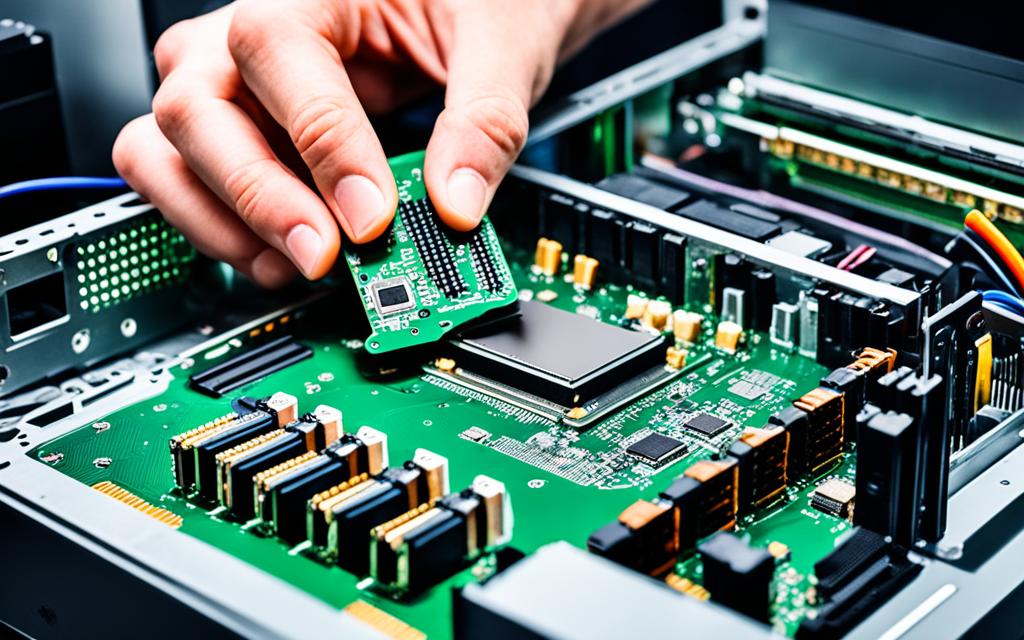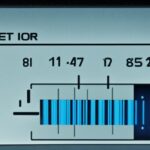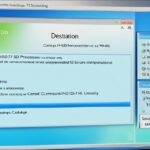Table of Contents
Adding an extra hard disk drive (HDD) to your Windows 10 system is a smart move. It increases your storage space and boosts your computer’s performance. This thorough HDD setup guide will make sure you know how to properly add the drive. You will learn about the need for more space and how to install, initialize, and format the new HDD. This will help your PC perform better and make your work more efficient. It’s good to know that most desktop PCs can have more than one HDD. This fits well with the trend of having several drives in one desktop computer1.
Key Takeaways
- Understand the benefits of adding an HDD, such as increased storage performance.
- Gather necessary tools to ensure a seamless Windows 10 hard drive installation.
- Always check for compatibility when selecting an internal hard drive.
- Follow structured steps to avoid hardware installation difficulties.
- Use Disk Management to easily manage and initialise your new drive.
- Choosing the NTFS file system is often the recommended practice for new volumes.
- Consider employing Storage Spaces for improved data redundancy and protection12.
Understanding the Need for Additional Storage
Today, everyone wants more space to store their digital stuff. The need for more storage grows as we collect more photos, apps, and games. Adding an HDD can solve this by boosting your device’s performance and giving you more room for your files.
The benefits of adding an HDD
One main advantage of an HDD is its ability to hold vast amounts of data without slowing down your computer. By having a second hard drive, you can keep your main one tidy, which makes your computer run better. Also, having more space means you can organize a big collection of files easily. For example, 4K Blu-ray videos need lots of space, and HDDs can provide that3.
Storage Spaces can combine several drives into one. This makes it easier to keep your files in order3.
When to consider upgrading your storage
If you often get warnings about low storage, or if your computer is slow, it’s time to think about more space. Every few years, the need for more space comes up, especially with our growing collections of TV shows and movies3. For laptops that can have extra drives, external storage is also a great solution4. So, if you have a lot of media, adding an HDD can keep your computer fast and safe from losing data.
To wrap it up, whether you have a desktop or a laptop, adding storage usually requires checking the SATA connections and if they fit a new HDD or SSD5. With a bit of planning, you can make sure your computer meets your storage needs.
Preparing for Installation
Make sure you have the right tools and know which type of HDD (Hard Disk Drive) you need before starting. Knowing the difference between HDD types is key. It can greatly impact the performance and storage of your computer.
Tools required for installing a new HDD
You will need certain tools for HDD installation:
- Screwdriver
- New HDD (either standard HDD or SSD)
- SATA data cable
Being prepared makes the setup process smoother. Without the right tools, you could run into issues.
Selecting the right type of HDD
Choosing between SSDs and traditional HDDs is a big decision. SSDs are faster but HDDs offer more storage and cost less. Think about what you need more: speed or space. Consider your budget and what your computer can connect to.
HDD sizes vary, with 3.5-inch for desktops and 2.5-inch for laptops. Today, many are choosing M.2 NVMe SSDs for top speed. Your choice affects the setup and success of your hard drive installation6.
How to Add a HDD to Windows 10
Adding a new HDD to your Windows 10 setup can really boost your computer’s abilities. You must be careful to install it correctly. This will help your computer connect well with the new drive.
Shutting down your PC
First, make sure to completely shut down your PC. This avoids any damage while you’re adding the new drive. It’s a critical step to ensure the computer is fully off. This reduces the chance of getting an electric shock or causing a short-circuit.
Opening the computer case
Then, open up the computer case. You might need to unscrew it or open latches. Remember to ground yourself to avoid electrostatic shock. This is important to keep your PC’s inner parts safe from static electricity.
Physically installing the HDD
With the case open, slot the new HDD into the right drive bay. Make sure it’s screwed in tightly. This prevents any movement or damage during operation7. Correct installation is key to the drive’s long-term performance and stability.
Connecting the HDD to the motherboard
Now, connect the HDD to the motherboard with a SATA cable. Make sure to use the first SATA channel for the best connection7. Plug in the power cable, close the case, and switch your computer back on. Your HDD is set up and ready, showing you how to install an HDD effectively.
Initialising Your New HDD
After you’ve fitted the new HDD, you must initialise HDD in Windows 10. This step makes the hard drive ready for use and ensures it’s properly recognised. First, go to Disk Management Windows 10 to manage your drives.
Accessing Disk Management
To open Disk Management, right-click the Start button and pick Disk Management. Here, you’ll find all connected drives, including your new HDD. It will likely show as ‘Unallocated’. If it says “Disk 0 is unknown, uninitialized, unallocated,” don’t stress—this is typical for new Windows 10/8/7 setups8.
Initialising the disk for use
Find the new drive and get ready to initialise it. Right-click the unallocated space and choose to initialise. Pick either Master Boot Record (MBR) or GUID Partition Table (GPT), depending on what you need. Normally, initialising a hard drive takes around 3-5 minutes8.
Choosing the partition style: MBR or GPT
Choosing between MBR and GPT depends on your new HDD’s size. Select MBR for disks up to 2 TB and GPT for those over 2 TB9. GPT can have up to 128 primary partitions and is better for system disks, offering quicker boot times9. Think about your needs and possible future expansion.
| Partition Style | Capacity Limit | Supported Partitions | Compatible Windows Versions |
|---|---|---|---|
| MBR | Up to 2 TB | 4 primary partitions | All Windows versions |
| GPT | Over 2 TB | 128 primary partitions | 64-bit Windows Vista and later |
Once you’ve made your choice, finish the initialisation. Your HDD will then be set for formatting and future use89.
Formatting and Setting Up the Drive
Now that you’ve got your new HDD ready, it’s time to format it for storage. This involves a few steps to get it ready for use.
Creating a new simple volume
Start by right-clicking the empty space in Disk Management and choose ‘New Simple Volume’. A wizard pops up to guide you through. You’ll usually want to use all the disk space for this volume. Once done, your drive will be ready to use.
Assigning a drive letter
The next step is to give your volume a drive letter. ‘D:’ is a popular choice if it’s not already taken. This makes finding the drive in Windows Explorer much easier, improving your computer use.
Choosing the file system format (NTFS)
For formatting, NTFS is the best choice for new drives. It handles big files well and works smoothly with Windows. Most Windows PCs use NTFS for external drives as it’s the go-to format10. Remember, formatting wipes all data on the drive. So, back up important files first11. Then, just follow the wizard to finish setting up.
Utilising Your New HDD
Once you’ve set up your new HDD, managing its space well is key to its best performance. Organising your files into folders can really speed up access and make your system run smoother. This way, you can work more efficiently.
How to make the most out of the added storage
To make your hard drive even better, try out some file management strategies. Making libraries to store related things together makes finding them easy. And using shared folders is great for working with others. These methods help you work faster and keep your files in order.
Setting up File History for backup
It’s also important to set up Windows File History on your new HDD. This keeps a backup of important files to protect your data. When setting it up, you choose what to back up and how often. It’s a smart move that makes sure you can always get your data back if needed. Using these options improves your HDD’s performance and life.
Conclusion
Adding more storage to your computer can really boost how well it performs and manages data. This Windows 10 HDD installation guide showed you vital steps for installing a new HDD. By following these steps, you solve storage problems and make your computer work better for the future.
Increasing your PC’s storage isn’t just about having space for more files. It’s a smart way to make your device last longer and work faster. Following this guide helps you move and manage data easily, ensuring your computer stays efficient for many years. More storage means you can easily access and organise your data, letting you focus on your work without worrying about running out of space.
Finally, you can either start fresh or move your existing operating system to the new drive. Choosing the right method is key. Taking time to follow these steps will lead to a more organised digital space. This makes your daily computer use more productive and efficient. Don’t wait to make this positive change today1213.
FAQ
What is the process to add a HDD to Windows 10?
First, you’ll need to get together your tools and the HDD. Next, install the HDD by connecting it to the motherboard. Lastly, use Disk Management to initialise and format the drive for use. It’s important to follow these steps correctly for the setup to work.
How do I choose the right type of HDD for my PC?
Think about what you need. If you want something cost-effective, a traditional HDD might be best. If speed is what you’re after, go for an SSD. Make sure the drive fits with your motherboard’s SATA ports too.
How can I increase storage on my PC?
To get more storage, you can add either an internal or external hard drive. Internal drives are fast and blend well with your system. External drives are great for moving files around. Choose based on what you need more.
What tools do I need to install a new HDD?
You will need a simple screwdriver, your new hard drive, and a SATA cable. These are the basics to get you started on the installation.
What steps should I take before installing a new HDD?
First off, make sure your PC is off and unplugged. Get your tools ready. Clear a space to work on opening the computer case. Check the HDD’s manual for any specific setup advice.
How do I format the new HDD after installation?
Go to Disk Management on Windows 10. Find the space marked for your new HDD. Right-click it and choose ‘New Simple Text’. The wizard will help you format it, usually to NTFS, to work with Windows.
What is the benefit of using Windows File History?
File History in Windows backs up your files automatically. It means you can get back earlier versions if needed. It’s great for keeping your documents safe and can be a lifesaver if you lose them by mistake.
Will adding a new HDD improve my computer’s performance?
Yes, a new HDD can make your computer run better. It’s especially helpful if you’re running out of space. Having a special drive for your files and games can make everything faster and smoother.
Should I choose MBR or GPT when initialising a new HDD?
For large drives, over 2 TB, go with GUID Partition Table (GPT). It supports bigger sizes and works better with new tech. Use Master Boot Record (MBR) for smaller or older drives.
Source Links
- https://www.dummies.com/article/technology/computers/operating-systems/windows/windows-10/how-to-install-a-second-internal-hard-drive-on-your-windows-10-device-255316/ – How to Install a Second Internal Hard Drive on Your Windows 10 Device
- https://learn.microsoft.com/en-us/windows-server/storage/disk-management/initialize-new-disks – Initialize new disks
- https://www.pcmag.com/how-to/how-to-combine-multiple-hard-drives-with-windows-storage-spaces – Consolidate Your Data: How to Combine Multiple Storage Drives in Windows
- https://www.easeus.com/partition-master/install-a-new-hard-drive-or-ssd.html – Beginner’s Guide – Install A New Hard Drive/SSD in Windows 10/8/7
- https://www.partitionwizard.com/partitionmagic/how-to-install-a-second-hard-drive.html – How to Install a Second Hard Drive in Your Laptop and Desktop PC – MiniTool Partition Wizard
- https://www.ubackup.com/articles/how-to-install-a-second-hard-drive-in-windows-10.html – Install a Second Hard Drive in Windows 10 (One-Stop Wizard)
- https://www.wikihow.com/Install-a-Hard-Drive – 3 Easy Ways to Install a Hard Drive: Guide (With Pictures)
- https://www.easeus.com/partition-manager-software/initialize-a-hard-drive.html – Full Guides: Initialize a Hard Drive on Windows 10/11
- https://www.diskpart.com/windows-10/initialize-disk-windows-10-7201.html – Ways to Initialize Disk Windows 10 and Common Disk Initialization Errors
- https://www.hellotech.com/guide/for/how-to-format-a-hard-drive-windows-10 – How to Format an External Hard Drive on Windows 10 or 11 : HelloTech How
- https://www.seagate.com/support/kb/how-to-format-your-drive-on-windows/ – How to format your drive on Windows | Support Seagate US
- https://www.easeus.com/partition-master/setup-ssd-hdd-and-change-os-disk-for-windows-10.html – Setup SSD/HDD and Change System/OS Disk for Windows 11/10
- https://softkeys.uk/blogs/blog/how-to-install-windows-10-on-new-hard-drive – How to Install Windows 10 on New Hard Drive?












